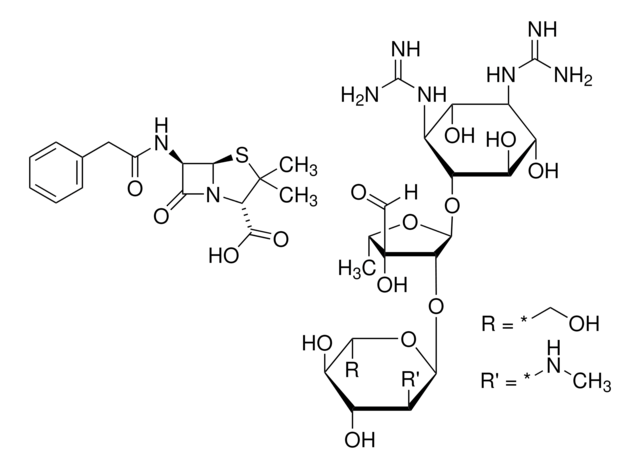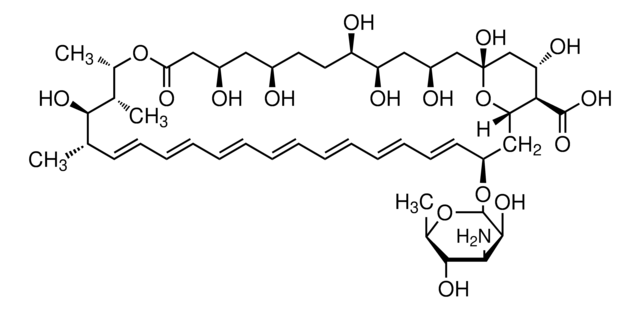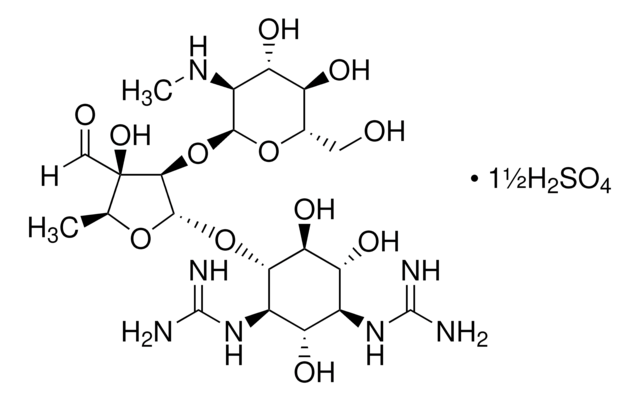11074440001
Roche
Penicillin-Streptomycin
suitable for cell culture, lyophilized (clear, colorless solution after reconstitution), non-sterile; 0.2 μm filtered, sufficient for 20 mL
Recommended Products
sterility
non-sterile; 0.2 μm filtered
Quality Level
form
lyophilized (clear, colorless solution after reconstitution)
usage
sufficient for 20 mL
manufacturer/tradename
Roche
concentration
50 mg/mL streptomycin in 0.9% NaCl (as sulfate)
50,000 U/mL penicillin in 0.9% NaCl
technique(s)
cell culture | mammalian: suitable
antibiotic activity spectrum
Gram-negative bacteria
Gram-positive bacteria
Mode of action
cell wall synthesis | interferes
protein synthesis | interferes
storage temp.
2-8°C
Related Categories
General description
Sensitive organisms:
- Gram-positive bacteria (penicillin)
- Gram-negative bacteria (streptomycin)
- Stability:Penicillin: 3 days
- Streptomycin: 3 days in media at +37 °C
Application
Physical form
Preparation Note
100 μg/ml streptomycin
Reconstitution
Other Notes
Signal Word
Danger
Hazard Statements
Precautionary Statements
Hazard Classifications
Acute Tox. 4 Inhalation - Acute Tox. 4 Oral - Repr. 2 - Resp. Sens. 1 - Skin Sens. 1
Storage Class Code
11 - Combustible Solids
WGK
WGK 2
Flash Point(F)
does not flash
Flash Point(C)
does not flash
Regulatory Information
Certificates of Analysis (COA)
Search for Certificates of Analysis (COA) by entering the products Lot/Batch Number. Lot and Batch Numbers can be found on a product’s label following the words ‘Lot’ or ‘Batch’.
Already Own This Product?
Documents related to the products that you have purchased in the past have been gathered in the Document Library for your convenience.
Difficulty Finding Your Product Or Lot/Batch Number?
How to Find the Product Number
Product numbers are combined with Pack Sizes/Quantity when displayed on the website (example: T1503-25G). Please make sure you enter ONLY the product number in the Product Number field (example: T1503).
Example:
Additional examples:
705578-5MG-PW
PL860-CGA/SHF-1EA
MMYOMAG-74K-13
1000309185
enter as 1.000309185)
Having trouble? Feel free to contact Technical Service for assistance.
How to Find a Lot/Batch Number for COA
Lot and Batch Numbers can be found on a product's label following the words 'Lot' or 'Batch'.
Aldrich Products
For a lot number such as TO09019TO, enter it as 09019TO (without the first two letters 'TO').
For a lot number with a filling-code such as 05427ES-021, enter it as 05427ES (without the filling-code '-021').
For a lot number with a filling-code such as STBB0728K9, enter it as STBB0728 without the filling-code 'K9'.
Not Finding What You Are Looking For?
In some cases, a COA may not be available online. If your search was unable to find the COA you can request one.
Our team of scientists has experience in all areas of research including Life Science, Material Science, Chemical Synthesis, Chromatography, Analytical and many others.
Contact Technical Service






